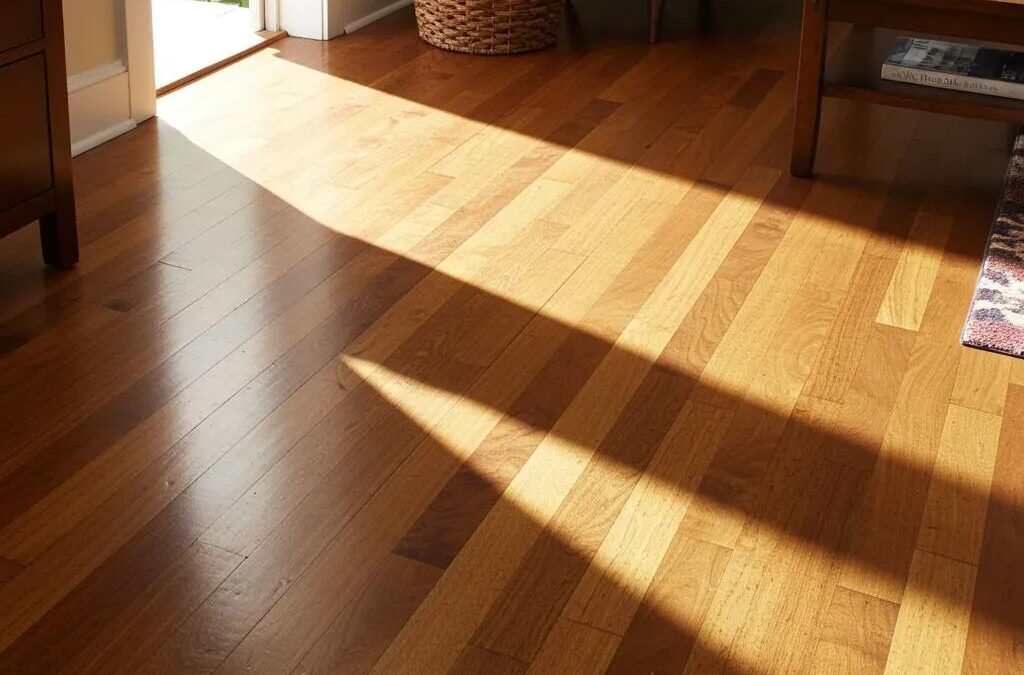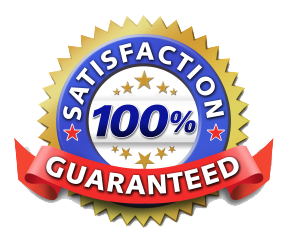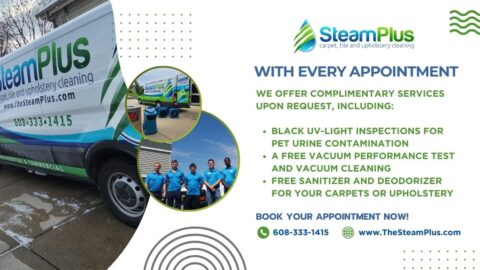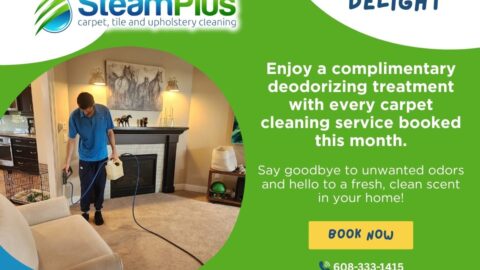Over time, even the most beautiful hardwood floors can lose their luster. Fortunately, a local hardwood floor buffing service can bring back that brilliant shine. This process involves gently abrading and polishing the surface, revitalizing its appearance without the need for a full sanding. In this guide, you’ll learn all about buffing: what it is, the typical costs in your area, the professional steps involved, how to keep your floors looking great afterward, how to choose the right service provider, and how it differs from refinishing or deep cleaning. We’ll also cover sustainable care routines. Throughout, you’ll find insights into how Steam Plus Carpet Cleaning and Water Restoration expertise in both carpet and hard-surface care offers a complete solution for your home’s flooring needs.
What Exactly Is Hardwood Floor Buffing and How Does It Restore Shine?
Hardwood floor buffing is a key maintenance technique that uses a specialized buffer and pad to lightly buff the existing finish. This process smooths out minor surface scratches and imperfections, then applies a protective polish, resulting in a renewed, vibrant sheen and improved slip resistance. By lifting embedded dirt and refining the surface, buffing enhances how light reflects off your floors, extending the life of the finish. It’s a way to refresh your floors without removing significant amounts of wood. This service focuses on enhancing appearance and addressing superficial wear while keeping your original finish intact.
After the initial buffing, a special polishing compound is applied. This compound fills in tiny grooves and bonds with the existing finish, creating a smooth, uniform, and reflective surface. Not only does this revive the look of your floors, but it also strengthens the finish against daily wear and tear. If you already trust Steam Plus Carpet Cleaning and Water Restoration for your carpet care, adding regular floor buffing ensures all your home’s flooring receives consistent, expert attention.
What Does the Hardwood Floor Buffing Process Entail?

The buffing process involves several careful steps: first, thoroughly removing all loose debris with a vacuum or dust mop. Then, selecting the right pad based on your floor’s finish type, calibrating the buffer machine, and applying the polishing compound.
Our technicians attach a suitable pad—ranging from soft to moderately abrasive—to a high-speed rotary buffer. They then work methodically across the floor in overlapping passes, ensuring an even abrasion and consistent distribution of the polishing compound. A final buffing pass with a clean, soft pad removes any excess polish and reveals a uniform, brilliant shine.
Technicians carefully adjust the buffer’s speed and the pad’s aggressiveness to match your specific wood species and the thickness of its finish. After buffing, a thorough inspection ensures a consistent sheen and checks for any remaining grit, confirming the floors are ready for normal use. Scheduling your floor buffing alongside your regular carpet cleaning appointments with Steam Plus Carpet Cleaning and Water Restoration can make your home maintenance routine much simpler.
How Is Buffing Different from Refinishing Hardwood Floors?
Buffing gently works on the top layer of the finish only. Refinishing, on the other hand, involves sanding down multiple layers of the finish until the bare wood is exposed. You can then choose to stain the wood and apply new protective coatings. Buffing is designed to address surface wear and minor scratches without changing the wood’s thickness, while refinishing is a more intensive process that completely renews the floor’s surface to correct deeper damage and wear.
The history of wood floor care shows that specialized machines have long been the go-to for achieving a polished finish.
Hardwood Floor Polishing Using Buffing Machines The procedure involves buffing with steel wool pads attached to a sanding machine. There is no satisfactory substitute for the polishing machine; manual polishing is excessively labor-intensive…Selection, installation, finish and maintenance of wood floors for dwellings, Unknown Author, 1938
| Service Type | Level of Intervention | Typical Downtime |
|---|---|---|
| Buffing | Surface treatment only, no wood removal | 1–2 hours per room |
| Refinishing | Multiple sanding passes down to bare wood | 2–4 days for preparation and curing |
Buffing is the perfect solution for routine upkeep and managing minor scratches. Refinishing is reserved for when the finish is significantly worn, there are deep gouges, or you wish to change the floor’s color. By choosing buffing, you can extend the time between costly refinishing jobs and help preserve your existing finish for longer.
Which Types of Hardwood Floors Can Be Buffed?
Most solid hardwood and engineered wood floors with a sound factory or site-applied polyurethane finish can be successfully buffed. Floors with wax, shellac, or certain water-based finishes require specific pad and compound selections tailored to their unique chemistry. Laminate and vinyl planks, however, are generally not suitable for buffing as they don’t have a true wood coating.
Commonly buffable floor types include:
- Solid wood floors (like oak, maple, cherry) with polyurethane coatings
- Engineered wood floors with factory-applied urethane
- Pre-finished hardwood floors sealed with aluminum oxide
- Site-finished planks treated with UV-cured urethane
It’s crucial to confirm finish compatibility to avoid using pads or compounds that could dull your floor instead of shining it. Experienced professionals, like those on the Steam Plus Carpet Cleaning and Water Restoration team, will always verify the finish type before buffing to ensure the best possible outcome.
What Are the Advantages of Professional Hardwood Floor Buffing?
Professional buffing significantly enhances your floors’ appearance, extends the life of their finish, improves slip resistance, and effectively hides minor scratches—all without the extensive process of a full refinish. Our trained technicians use the right pads and high-quality, eco-friendly polishes, ensuring even coverage and preventing unsightly spots or buildup.
Key benefits you’ll enjoy include:
- A brilliant shine that can boost your home’s appeal and value
- Concealment of minor scratches and scuffs
- A reinforced finish that better resists abrasion and UV damage
- A much quicker service than refinishing, with minimal disruption to your day
Regular buffing also fits perfectly into your home maintenance schedule, especially when coordinated with carpet cleaning appointments, offering complete floor care from a single, trusted provider.
What’s the Typical Cost for Local Hardwood Floor Buffing Services?
In most areas, professional hardwood floor buffing typically costs between $1.00 and $2.50 per square foot. This price can vary based on the floor’s current condition, the type of finish, and the size of the area being treated. The cost usually covers the abrasive pads, polishing compounds, machine operation, and cleanup. You might also find that bundling buffing with other services, like carpet cleaning from Steam Plus Carpet Cleaning and Water Restoration, can lead to attractive package discounts.
Historical cost analyses show that buffing and waxing have been recognized as economical maintenance solutions for wood floors for many years.
Cost Analysis of Hardwood Floor Refinishing: Buffing and Waxing In addition to the waxing and buffing of the hardwood floors, the building owners who had hardwood…Flooring costs: a comparison of installation and maintenance costs for three types of residential flooring, 1968
Here’s a general cost comparison for common floor care services:
| Service Type | Starting Price per Sq Ft | Level of Intervention | Typical Project Duration |
|---|---|---|---|
| Buffing | $1.00–$2.50 | Surface abrasion only | 1–2 hours per 300 sq ft |
| Polishing (Recoating) | $1.50–$3.00 | Application of a fresh finish coat | 4–6 hours including curing time |
| Refinishing | $3.00–$8.00 | Full sanding and recoating | 2–4 days including curing time |
What Factors Influence the Price of Hardwood Floor Buffing?
Several elements can affect the final cost of buffing your hardwood floors:
- The total floor area and how complex the room layouts are
- The type of existing finish and how worn it is
- The number of corners, edges, and thresholds that require detailed hand-work
- The quality and any eco-friendly certifications of the polishing compounds used
- Local labor rates and any travel distances for the technicians
Before providing a precise quote, technicians will typically conduct an on-site assessment to measure the square footage, evaluate the finish’s condition, and determine the most appropriate pad aggressiveness.
What Is the Average Cost Per Square Foot for Buffing?
For standard residential spaces up to 1,000 square feet, you can expect the average price for buffing to be between $1.25 and $2.00 per square foot. If you have high-end finishes or opt for specialized compounds, such as UV-cured or low-VOC polishes, the rate might be closer to the higher end of this range. For commercial properties with ongoing maintenance agreements, bulk discounts can often bring the price down to below $1.00 per square foot.
How Does Buffing Cost Compare to Refinishing and Polishing?
Buffing is consistently the most budget-friendly maintenance option when compared to full refinishing or recoating. While refinishing involves replacing all finish layers and fixing deep damage, buffing offers a surface refresh at approximately one-third of the cost. Polishing, or recoating, falls in the middle; it adds a new layer of finish without the sanding involved in refinishing.
How Can I Get Accurate Local Quotes for Hardwood Floor Buffing?
To ensure you get reliable estimates for buffing services:
- Request on-site inspections from at least two different local providers.
- Confirm the recommended pad types and ensure they are compatible with your floor’s finish.
- Ask about potential discounts for bundling services, such as with carpet or tile cleaning.
- Inquire about any available upgrades for eco-friendly compounds and the warranties offered.
Booking your buffing service at the same time as your regular carpet cleaning with a single provider can simplify scheduling and potentially offer package pricing benefits.
What Are the Professional Processes for Hardwood Floor Buffing and Polishing?
Professional hardwood floor buffing and polishing involve a meticulous sequence: removing debris, preparing the equipment, gently abrading the finish, applying a specialized compound, and finally enhancing the sheen. Our experienced technicians use calibrated buffer speeds and precise compound-pad combinations to achieve consistent gloss levels and effectively mask minor scratches.
Achieving the best polishing results on wood floors has historically relied on specialized techniques and professional-grade equipment.
Professional Techniques for Wood Floor Polishing Following the installation of a wood floor, the process may involve four distinct stages. A minority of professional floor installers utilize silicon carbide abrasives. This work can be performed advantageously using a floor polishing machine equipped with a wire brush attachment. Finishing and maintaining wood floors, Unknown Author, 1959
The typical stages of our professional process include:
- A thorough pre-service inspection and dust-mopping of the floor.
- Careful selection of the abrasive pad, matched to the finish’s durability.
- Using the rotary buffer to gently abrade the surface coating.
- Applying and spreading the polishing compound evenly.
- A final buffing pass with a soft pad to create a uniform shine.
Our technicians also perform a detailed post-buff cleaning, vacuuming away any residual dust and compound, ensuring your floors are ready for light foot traffic almost immediately.
What Equipment and Cleaning Agents Are Used in Buffing?
We utilize high-speed rotary buffers or low-speed orbital machines, paired with appropriate abrasive pads and specialized polishing solutions. Our eco-certified compounds are formulated with non-toxic polymers that help restore the finish’s flexibility and luster. To ensure a dust-free application, we use microfiber dust mops, HEPA vacuums, and tack cloths.
| Equipment | Purpose | Benefit |
|---|---|---|
| Rotary Buffer | Gently abrades the finish layer | Ensures consistent surface smoothing |
| Orbital Floor Polisher | Lightly works in polish | Minimizes the appearance of swirl marks |
| Abrasive Pads (Medium) | Removes micro-scratches | Helps conceal minor blemishes |
| Microfiber Mop | Removes dust before buffing | Prevents grit from getting embedded in the compound |
What Are the Step-by-Step Stages of Hardwood Floor Buffing?
Our professional hardwood floor buffing process follows these five key stages:
- Preparation – We clear furniture from the area and vacuum thoroughly to remove all loose dirt and grit.
- Pad Setup – We attach the correct abrasive pad to the machine and calibrate its speed for optimal performance.
- Surface Buffing – The buffer is moved in overlapping passes across the floor to evenly abrade the finish.
- Polish Application – A thin, consistent layer of our specialized polishing compound is applied.
- Final Buff & Cleanup – A clean, soft pad is used to remove excess compound and reveal a uniform, beautiful shine.
How Do Professionals Remove Scratches and Dullness?
Our technicians target scratches and dull areas by selecting an abrasive pad that matches the level of wear on your finish. Medium-grade pads are effective for minor blemishes, while gentler pads are used for polishing high-traffic zones. The polishing compound contains polymers that fill in microscopic scratches and create a cohesive topcoat, effectively blurring remaining imperfections and restoring the floor’s natural light reflection.
How Long Does a Typical Buffing Service Take?
A standard residential buffing service usually takes about 1–2 hours for every 300 square feet, including the time for preparation and cleanup. Larger homes or multiple rooms can often be completed within a single day. For commercial spaces, we can schedule buffing during off-hours to avoid any disruption to your business operations. Coordinating your buffing service with Steam Plus Carpet Cleaning and Water Restoration’s carpet services can help maximize efficiency and potentially reduce the total time needed for your visit.
How to Maintain Your Hardwood Floors After Buffing?
Keeping your buffed floors looking their best involves simple yet effective practices: gentle cleaning, protective measures, and timely re-buffing to maintain that beautiful shine and the integrity of the finish. Following these routines will help your floors stay looking new for longer and reduce the need for more intensive refinishing.
Essential maintenance practices include:
- Dust-mopping weekly using microfiber tools to capture fine particles.
- Cleaning monthly with a pH-balanced hardwood floor cleaner.
- Placing durable entry mats at all doorways to trap grit and moisture.
- Applying protective pads to the legs of all furniture, including chairs and tables.
What Are the Best Practices for Hardwood Floor Maintenance?
To protect your newly buffed floors, always use non-abrasive cleaning agents, wipe up spills immediately, and maintain consistent indoor humidity levels. Avoid using steam mops or harsh chemical cleaners, as these can damage the protective coatings. Consider using area rugs in high-traffic zones to minimize wear and schedule seasonal buffing appointments to address any new surface scratches.
How Often Should Hardwood Floors Be Professionally Buffed or Cleaned?
For homes with moderate foot traffic, professional buffing is typically recommended every 12 to 18 months. Commercial spaces may benefit from buffing every 6 to 9 months. An annual buffing, combined with deep cleaning twice a year, is an excellent way to preserve the finish and extend the time between full refinishing projects, optimizing your maintenance budget.
What Are the Differences Between Polishing and Buffing for Maintenance?
Buffing involves lightly abrading the existing finish to remove surface wear and dullness. Polishing, also known as recoating, applies a fresh protective layer of finish without any abrasion. Polishing can address minor thinning of the finish by adding new polymer coats, but it doesn’t have the scratch-removal capabilities of buffing.
How to Protect Hardwood Floors from Wear and Tear?
Preventing wear and tear is key. Use floor protectors under all furniture, rotate area rugs periodically to prevent uneven fading, and consider implementing a “no shoes indoors” policy. Maintaining a consistent indoor humidity level, ideally between 35–55%, is also crucial, as it prevents the wood from contracting or expanding excessively, which can damage finishes over time.
Where Can I Find Reliable Local Companies for Hardwood Floor Buffing and Maintenance?
When selecting a trustworthy provider, it’s important to look for proper certifications, high-quality equipment, and environmentally conscious practices. Local companies that specialize in hard-surface care offer expertise with professional machinery, use eco-friendly compounds, and provide transparent pricing.
Look for these qualities in a reliable provider:
- Technicians certified by organizations like the IICRC, who understand finish chemistry.
- Use of low-VOC or water-based polishing compounds.
- Clear service agreements that detail the process and any warranties.
- The ability to schedule carpet and hardwood services together.
Companies that offer bundled services, such as Steam Plus Carpet Cleaning and Water Restoration for both carpet cleaning and hardwood buffing, provide comprehensive maintenance plans that simplify your home care routine.
What Should I Look for in a Professional Hardwood Floor Buffing Service Provider?
Seek out providers who have documented training in various finish types, use up-to-date equipment, and can provide proof of liability insurance. Don’t hesitate to ask about their pad rotation schedules and request safety data sheets for the compounds they use. Reputable providers will readily share before-and-after photos of their work and offer detailed explanations of their process.
How Can I Verify Eco-Friendly and Safe Cleaning Practices?
Ask for product data sheets for the polishing compounds they use and inquire about their VOC (Volatile Organic Compound) content. Look for providers who participate in certified green cleaning programs or display third-party eco-labels, which indicate adherence to safety standards. They should also be able to offer scheduling options that minimize chemical exposure for pets and children.
What Are Common Customer Questions About Local Hardwood Floor Services?
Many customers frequently ask about how long the service will last, how costs compare to other options, how effective scratch removal is, and what warranties are provided. Clear answers regarding estimated service times, price per square foot, and warranty coverage help build trust and enable informed decisions.
How Should I Read and Use Customer Reviews and Testimonials?
When evaluating reviews, pay attention to comments about service consistency, transparency, and post-service support. Look for mentions of punctuality, the longevity of the finish, and the thoroughness of the cleanup. Cross-referencing reviews across different platforms can help confirm their authenticity and identify providers who consistently deliver excellent results.
What Are the Differences Between Hardwood Floor Buffing, Refinishing, and Deep Cleaning?
| Service | Process | Benefit | Recommended Frequency |
|---|---|---|---|
| Buffing | Light abrasion & polish application | Restores shine, hides minor scratches | Every 12–18 months |
| Polishing (Recoating) | Application of a fresh finish coat | Adds a protective layer, evens out sheen | Every 18–24 months |
| Refinishing | Sanding down to bare wood & full recoating | Corrects deep damage, allows for stain color change | Every 5–10 years |
| Deep Cleaning | pH-balanced scrubbing & rinsing | Removes embedded dirt, allergens, and grime | Quarterly or as needed |
When Is Buffing the Better Choice Over Refinishing?
Buffing is the ideal choice when the wear on your floor’s finish is superficial, with no significant discoloration or deep gouges. It can postpone the need for a full refinishing for several years, offering a quicker process and a lower cost for floors that still have most of their original coating intact.
What Does Hardwood Floor Deep Cleaning Typically Include?
Deep cleaning involves dust-mopping, applying a pH-balanced detergent, gently agitating the surface with soft brushes, and thoroughly rinsing away all dirt and allergens. This process prepares your floors for buffing or polishing by ensuring the finish is completely free of any films or residue.
Can Engineered Hardwood Floors Be Buffed?
Yes, engineered hardwood floors with a factory urethane finish of at least 2-3 mm can be buffed. However, floors with thinner veneers or certain UV-cured finishes may require gentler pads and specialized compounds to avoid over-abrading the finish layer.
How Do Different Wood Finishes Affect the Choice of Service?
Polyurethane and aluminum-oxide finishes generally respond well to medium-grade pads and standard compounds. Wax or shellac finishes, however, require specialized emulsions and much gentler pads. Water-based finishes often need low-VOC compounds to maintain their clarity and prevent cloudiness.
Frequently Asked Questions About Hardwood Floor Buffer Services
Customers often inquire about the durability of buffing results, the extent of scratch removal, whether DIY buffing is feasible, and the safety of the equipment used. Providing clear explanations about the outcomes of buffing, the types of buffer machines available, and recommended maintenance intervals empowers homeowners to confidently choose professional services—especially when bundling with carpet cleaning from Steam Plus Carpet Cleaning and Water Restoration for a complete floor care solution.
How Long Do the Results of Hardwood Floor Buffing Typically Last?
Under normal residential use, a professional buffing service typically maintains your floor’s shine and scratch resistance for about 12–18 months. This duration can vary depending on foot traffic levels and how consistently you follow recommended maintenance routines. Sticking to regular dust-mopping and cleaning will help preserve the buffing results until your next service.
Can Buffing Remove Pet Stains and Odors?
Buffing is effective for addressing surface wear and dullness, but it cannot remove deep-set stains or odors that have penetrated the wood pores. For these issues, combining buffing with specialized stain-removal cleaning agents and odor-neutralizing treatments is necessary to achieve both aesthetic restoration and improved indoor air quality.
Is DIY Hardwood Floor Buffing Recommended?
We generally do not recommend DIY buffing. There’s a significant risk of uneven abrasion, creating swirl marks, or thinning the finish if the wrong pads or compounds are used for your specific finish type. Professional technicians ensure the correct pad selection, precise machine calibration, and accurate compound application for consistently beautiful results.
What Types of Floor Buffer Machines Do Professionals Use?
Professionals typically use high-speed rotary buffers for effectively abrading the finish and low-speed orbital polishers for blending compounds and achieving a final sheen. Many of these machines feature variable speed settings and allow for quick pad changes, enabling technicians to adapt their approach to different wood species and finish chemistries.
Restoring the natural shine of your hardwood floors through professional buffing is a cost-effective method to maintain their beauty and value. It perfectly complements routine carpet cleaning services, all available from one trusted provider. Regular buffing, combined with proper home maintenance and informed service choices, ensures your floors remain vibrant, durable, and protected for years to come.








